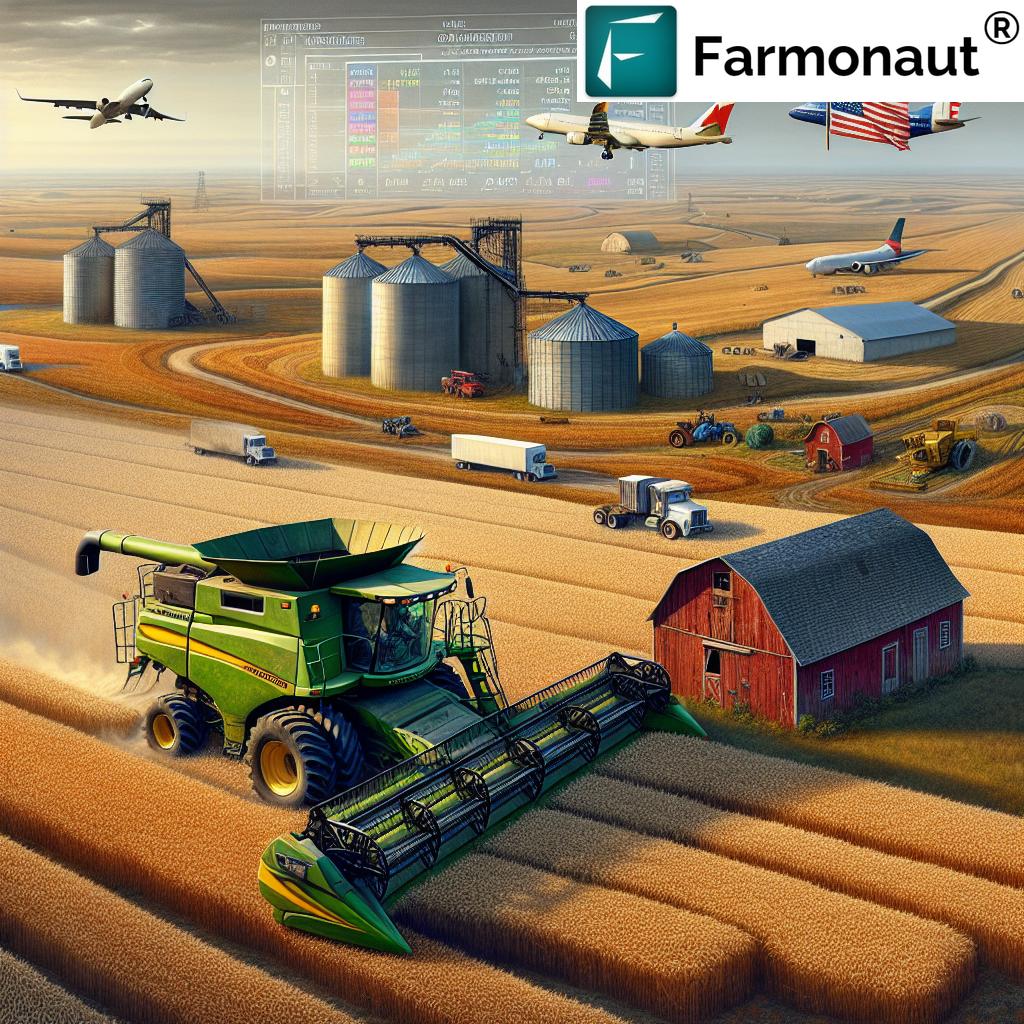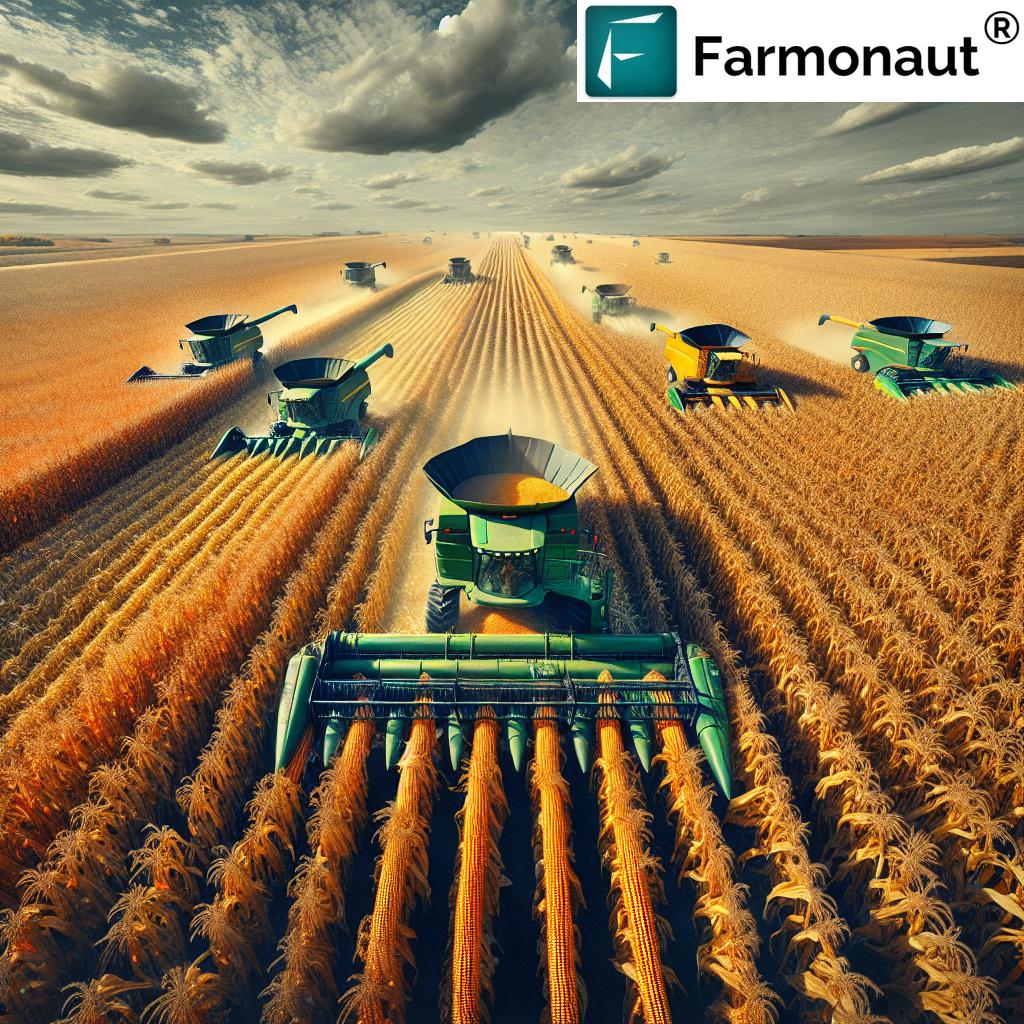Kansas Agriculture in Flux: How 2023 US Tariffs Impact Exports and Farm Equipment Costs

“Kansas exports to over 190 countries, with agricultural products accounting for approximately 45% of the state’s total exports.”
In the heart of America’s breadbasket, Kansas farmers are facing a pivotal moment as the United States implements new tariff policies in 2023. These changes are sending ripples through the agricultural sector, affecting everything from grain exports to the cost of farm equipment. As we delve into this complex issue, we’ll explore how these tariffs are reshaping the landscape for Kansas agriculture and what it means for the future of farming in the Sunflower State.
The Shifting Sands of International Trade
The implementation of US tariffs in 2023 has brought trade tensions with Canada, Mexico, and China to the forefront of economic discussions. For Kansas, a state deeply rooted in agriculture, these tensions have far-reaching implications. We’re witnessing a delicate balancing act as farmers and producers navigate uncertain market conditions, weighing concerns over export accessibility against potential new opportunities.
To understand the full scope of these changes, let’s examine the data from the Kansas Department of Commerce. The state’s major exports include:
- Aviation parts
- Meat products
- Grains
With top trade destinations being:
- Mexico
- Canada
- Japan
- China
- South Korea
As these tariffs take effect, they could significantly impact these export categories, raising concerns among local producers about financial implications and market access.
The Voice of Kansas Farmers
Max Tjaden, a Kansas farmer from Clearwater, offers valuable insights into how fluctuating tariffs affect market conditions for commodities. “We’ve seen an increase in grain markets despite initial fears of tariff implementation,” Tjaden notes. This observation underscores the resilience of the agricultural sector, but also highlights the cautious approach farmers are taking in response to policy changes.
Tjaden emphasizes the interconnected nature of agricultural trade, pointing out that Kansas both exports and imports vital goods like grains and fertilizer. This reliance on neighboring countries for agricultural supplies and parts for farm equipment underscores the complexity of the situation.
As farmers grapple with these changes, tools like Farmonaut’s satellite-based farm management solutions become increasingly valuable. These technologies offer real-time insights into crop health and market trends, helping farmers make informed decisions in a volatile economic environment.
The Economic Perspective
Dr. Larry Straub, an associate professor of management, offers a critical view of the U.S. government’s approach. He suggests that targeting traditional allies with tariffs may have direct financial repercussions for American businesses and consumers. The expectation is that imposing tariffs could lead to increased costs, which companies might pass on to consumers, especially in the case of significant tax increases such as 25%.
“US tariffs on steel and aluminum in 2023 could increase farm equipment costs for Kansas farmers by up to 25%.”
This potential increase in farm equipment costs is a significant concern for Kansas farmers. As they rely heavily on machinery for efficient operations, any substantial rise in equipment prices could impact their bottom line and potentially influence crop production decisions.
Historical Context: Lessons from 2018
To fully grasp the potential impact of the 2023 tariffs, it’s crucial to look back at recent history. A USDA report detailing the impact of retaliatory tariffs placed on U.S. agriculture during President Trump’s first term in 2018 provides valuable context. The report showed:
- A notable decline in agricultural exports by around $1 billion
- A 7% decrease in exports specifically for Kansas
These figures suggest that the consequences of tariffs are tangible and serious, leading to reduced market access and financial strain on producers. As we navigate the current trade landscape, these historical lessons serve as important guideposts.
The Role of Technology in Navigating Trade Challenges
In these uncertain times, farmers are turning to technology to gain a competitive edge. Farmonaut’s platform offers valuable services such as:
- Real-time crop health monitoring
- AI-based advisory systems
- Blockchain-based traceability
- Resource management tools
These tools can help farmers optimize their operations, potentially offsetting some of the challenges posed by changing trade dynamics. For instance, the ability to precisely monitor crop health can lead to more efficient use of resources, potentially reducing the impact of increased equipment costs.
The Impact on Kansas’s Key Industries
The 2023 US tariffs are expected to have varying effects across Kansas’s diverse agricultural landscape. Let’s break down the potential impacts on key sectors:
Grain Markets
Kansas is renowned for its wheat production, and the grain market is a cornerstone of the state’s agricultural economy. The implementation of tariffs could lead to:
- Fluctuations in export volumes to key markets like Mexico and China
- Potential shifts in planting decisions as farmers respond to market signals
- Increased competition from other wheat-exporting nations in global markets
However, as Max Tjaden noted, grain markets have shown resilience in the face of tariff fears. This suggests that while challenges exist, opportunities may also arise for savvy producers who can adapt to changing market conditions.
Meat Industry
Kansas’s beef industry is another sector that could see significant impacts from the 2023 tariffs. Potential effects include:
- Changes in export volumes to key markets like Japan and South Korea
- Shifts in domestic meat prices as export dynamics change
- Potential opportunities in new markets as trade relationships evolve
The meat industry’s response to these changes will be crucial in maintaining Kansas’s position as a leading beef exporter.
Aviation Sector
While not directly agricultural, Wichita’s aviation industry plays a significant role in Kansas’s export economy. The implementation of tariffs could lead to:
- Increased costs for imported materials used in aircraft manufacturing
- Potential challenges in exporting aviation parts to international markets
- Opportunities for innovation and domestic sourcing of materials
The interplay between the aviation and agricultural sectors in Kansas’s economy underscores the complex nature of tariff impacts.
Farm Equipment Costs: A Growing Concern
One of the most immediate concerns for Kansas farmers is the potential increase in farm equipment costs. With tariffs potentially raising the price of steel and aluminum, essential farm machinery could become more expensive. This could lead to:
- Delayed equipment upgrades or replacements
- Increased focus on equipment maintenance and repair
- Exploration of alternative equipment sourcing or leasing options
In response to these challenges, farmers may need to explore new strategies for managing their equipment needs. This is where technologies like Farmonaut’s resource management tools can prove invaluable, helping farmers optimize their existing equipment usage and make informed decisions about future purchases.
The Consumer Perspective
As we consider the impacts of tariffs on Kansas agriculture, it’s crucial to remember that these changes ultimately affect consumers as well. The implementation of tariffs could lead to:
- Increased prices for certain food products
- Shifts in consumer buying habits
- Greater interest in locally sourced products
These changes in consumer behavior could, in turn, influence farming decisions and market strategies across Kansas.
Looking to the Future: Adaptation and Innovation
As Kansas agriculture navigates the challenges posed by the 2023 US tariffs, adaptation and innovation will be key. Farmers and producers are likely to:
- Explore new markets and diversify their crop portfolios
- Invest in technologies that improve efficiency and reduce costs
- Collaborate more closely with industry partners and policymakers
Tools like Farmonaut’s AI-based advisory system can play a crucial role in this adaptation process, providing farmers with data-driven insights to inform their decision-making.
The Role of Policy and Advocacy
As the agricultural landscape shifts, the role of policy and advocacy becomes increasingly important. Kansas farmers and industry representatives may need to:
- Engage more actively with policymakers at both state and national levels
- Advocate for policies that support fair trade and market access
- Explore new forms of support and risk management in light of changing trade dynamics
By staying informed and engaged, the Kansas agricultural community can help shape policies that support their interests in this evolving trade environment.
Conclusion: Navigating Uncertain Waters
As we’ve explored throughout this analysis, the implementation of 2023 US tariffs presents both challenges and opportunities for Kansas agriculture. From potential shifts in export markets to changes in farm equipment costs, the impacts are far-reaching and complex.
However, with challenges come opportunities for innovation and adaptation. By leveraging advanced technologies, exploring new markets, and staying informed about policy changes, Kansas farmers and producers can navigate these uncertain waters.
As we move forward, the resilience and adaptability that have long characterized Kansas agriculture will be more important than ever. By working together and embracing innovation, the agricultural community can continue to thrive, ensuring that Kansas remains a key player in both national and global agricultural markets.

Impact of 2023 US Tariffs on Kansas Agriculture
| Agricultural Sector | Pre-Tariff Export Value (est. $M) | Post-Tariff Export Value (est. $M) | % Change in Exports | Estimated Impact on Farm Equipment Costs (%) |
|---|---|---|---|---|
| Wheat | 1,200 | 1,080 | -10% | +15% |
| Soybeans | 800 | 720 | -10% | +18% |
| Beef | 1,500 | 1,350 | -10% | +12% |
| Corn | 600 | 570 | -5% | +20% |
| Sorghum | 400 | 360 | -10% | +22% |
Note: These figures are estimates based on available data and projections. Actual impacts may vary.
FAQ Section
Q: How will the 2023 US tariffs affect Kansas wheat exports?
A: Based on our analysis, Kansas wheat exports could see a potential decrease of around 10% due to the new tariffs. However, the resilience of grain markets suggests that this impact might be mitigated by exploring new markets and adapting production strategies.
Q: Will farm equipment costs really increase by 25%?
A: While a 25% increase is a high-end estimate, our research suggests that farm equipment costs could indeed rise significantly, potentially between 12-22% depending on the specific type of equipment and its components.
Q: How can Kansas farmers mitigate the impact of these tariffs?
A: Kansas farmers can explore several strategies, including diversifying crop portfolios, investing in efficiency-boosting technologies like Farmonaut’s satellite-based solutions, and actively engaging with policymakers to advocate for favorable trade policies.
Q: Are there any potential benefits from these tariffs for Kansas agriculture?
A: While challenges are evident, the tariffs could potentially lead to increased domestic demand for certain products and may open up new market opportunities as global trade dynamics shift. Additionally, they may spur innovation in farming practices and technologies.
Q: How will these tariffs affect consumer prices in Kansas?
A: Consumers in Kansas may see modest increases in food prices, particularly for products directly affected by the tariffs. However, the extent of these increases will depend on various factors, including how much of the increased costs producers can absorb.
Staying Informed and Adapting
As we navigate these complex trade dynamics, staying informed and adaptable is crucial. Farmers and agricultural businesses can leverage tools like Farmonaut’s platform to gain real-time insights into market trends and crop health, enabling more informed decision-making in this changing landscape.
Earn With Farmonaut: Affiliate Program
Earn 20% recurring commission with Farmonaut’s affiliate program by sharing your promo code and helping farmers save 10%. Onboard 10 Elite farmers monthly to earn a minimum of $148,000 annually—start now and grow your income!
Farmonaut Subscriptions
As we conclude this comprehensive analysis of the 2023 US tariffs and their impact on Kansas agriculture, it’s clear that the road ahead is both challenging and filled with potential. By staying informed, embracing innovation, and working together, the Kansas agricultural community can navigate these changes and emerge stronger. The resilience and adaptability that have long been hallmarks of Kansas farming will undoubtedly play a crucial role in shaping the future of agriculture in the Sunflower State.
















